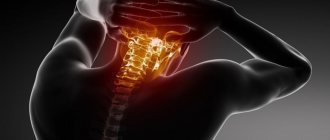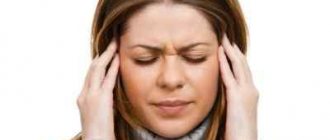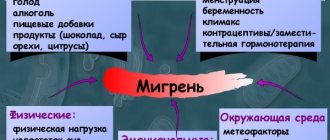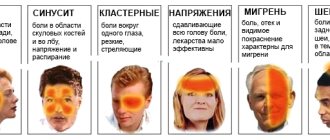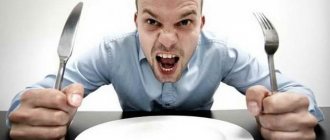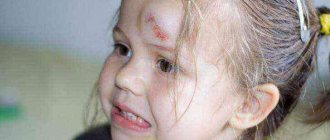Migraine is a neurological disease characterized by periodic attacks of headache on one side of the head. This disease is associated with dilation of the vessels of the dura mater.
Symptoms include: precursors in the form of weakness and inability to concentrate, starting from the temple or back of the head and affecting only half of the head, throbbing pressing pain, periodic change of sides of pain localization, an attack of nausea (with or without vomiting) and sensitivity to light or sound, increased pain when suddenly moving or walking.
Causes of migraine:
- cerebral vasospasm due to increased serotonin,
- activation of the trigeminovascular system (in people with increased excitability of the cerebral cortex),
- activity of the hypothalamus,
- uneven dilation of blood vessels in the brain,
- genetic predisposition,
- diseases of the central nervous system,
- metabolic disease,
- taking hormonal drugs,
- premenstrual syndrome, etc.
Factors that provoke migraines are: stress, hunger, physical overexertion, consumption of foods containing tyramine, phenylethylamine (chocolate, wine, citrus fruits, etc.), lack of sleep or oversleeping, environment (strong odors, very bright light, etc.) .
There are the following types of migraine:
- sleep migraine (before bedtime or after sleep),
- panic (vegetative) migraine (accompanied by palpitations, suffocation, chills, lacrimation or swelling of the face),
- menstrual migraine,
- chronic migraine (15 times a month for three months).
In addition to the listed types, migraine with aura (classical migraine) is separately distinguished - this is a chronic neurological disease in which the pain is pulsating in nature.
1-2 hours before the onset of such migraine attacks, the following signs appear: reversible speech impairment, reversible visual impairment (flickering spots, stripes, blurred images, bright flashes), reversible sensory disturbances (numbness, tingling in the limbs), causeless psycho-emotional disorders (irritation , apathy, fear, aggression, drowsiness).
Psychosomatics of migraine
According to most authors, the head symbolizes a person's individuality.
Considering that pain in general is a signal that something is wrong and requires attention, pain in the head indicates that a person is “hitting himself over the head” with low self-esteem and reproaches against himself. That is, a person “beats” himself according to his individuality.
How can it be?
Blood flow through the cerebral vessels is disrupted due to overwhelming negative thoughts and feelings towards oneself: hidden claims against oneself, the desire to be the best in everything and dissatisfaction with one’s own successes, feelings of guilt before loved ones, suppression of one’s own desires, psycho-emotional dependence on other people’s opinions, etc. .d.
Often, migraine patients are characterized by rational thinking, the desire to control the situation and restraint in emotions. Staying in this mode for too long strains your head, which leads to overload. Secrecy, nervousness, depression, pessimistic thoughts and other negative states only complicate the disease.
Migraines also affect people who are distinguished by resentment, resentment, suppressed anger, a painful reaction to humor, hidden aggression towards the outside world, dissatisfaction with living conditions with a simultaneous lack of desire to change for the better, inability to forgive, suspiciousness, anxiety, etc.
How to cope with migraines
Psychologists give advice that will really help you cope with pain. To do this you need:
- Do not idealize the world and do not strive for perfection.
- Reduce claims towards others and yourself, all people are different. Do not think that personal presence or inaction can cause a worldwide catastrophe.
- Learn to identify negative emotions and get rid of them. Admit that specific actions or reasons cause irritation, anger, and aggressiveness.
- Recognize stress and try to observe it from the outside. The best cure for mental stress is physical exercise.
- Make friends only with kind and sincere individuals. This will give you the opportunity to recharge with positive energy and receive positive emotions.
- Love yourself and not listen to the advice of others. Find something you love and devote your free time to it, for example knitting or macrame.
INTERESTING fact: Psychosomatics of diabetes mellitus
Recording the events preceding the attack will help to understand the causes of the psychosomatics of migraine and headache.
Health to you!
Psychological causes of migraine
Louise Hay explains psychosomatic migraine by the following reasons: hatred of coercion, resistance to the course of life, sexual fears.
Psychologist Liz Burbo claims that this illness appears in people who do not give themselves the right to be themselves. Such people feel guilty when they try to speak out against those who have significant influence over them. This behavior is due to the fact that they do not live their lives as they want, but obey an authoritative or close person.
According to Liz Burbo, migraines often affect people who have difficulties in their sex life. This is due to the fact that they do not develop their creativity (the genitals are the symbol of creativity in humans).
Dr. V. Sinelnikov writes that this illness haunts people who strive for perfection, but through self-criticism and scolding themselves, blaming and punishing themselves. Such people, according to the doctor, are full of inferiority complexes and feelings of guilt, which manifest themselves physically as pain.
Another psychological cause of migraines, according to Sinelnikov, is hypocrisy. If a person is forced to communicate with an unpleasant person, one hemisphere of his brain registers unpleasant feelings, and the other - his external behavior (forced to smile, etc.). It turns out that some muscles are tense, while others are relaxed, and this discrepancy between internal and external causes pain.
Headache: possible causes
Migraine is not the only cause of headaches. You should not self-diagnose migraine. In order to diagnose the disease, you should undergo an examination and be observed for a long time by a neurologist.
What causes headaches?
Stress When experiencing negative emotions, a person “wilts” - this can be seen in his posture, the position of his head, and his dull gaze. Negative experiences are a common cause of severe headaches. Extremely unpleasant sensations: burning, aching or throbbing can be felt in the head, neck or face.
Muscle tension in the head and neck
Staying in one position for a long time with the head or neck leads to a dull pain, as if the head is being squeezed in a vice. Muscle tension can be associated with a monotonous body position, for example, when working at a computer; with being in a state of emotional stress or depression.
Arterial hypertension
Pain with high blood pressure causes the feeling of a bandage that squeezes the head in the morning. By evening the feeling of squeezing goes away.
Cluster pain
The vast majority of people suffering from cluster pain attacks are men who smoke. The symptoms of cluster pain are reminiscent of a migraine: excruciating pain localized in the head - throbbing, burning, boring. The disease differs from migraines in that with them either one nostril becomes blocked or a severe runny nose begins - also in one nostril. The attack lasts about 20 minutes, but can be repeated many times during the day. The pain occurs suddenly and may stop for several months.
Menstrual cycle
The origin of headaches associated with the menstrual cycle is as mysterious as the cause of migraines.
Physical exercise
The occurrence of pain with the slightest physical activity: bending over, turning the head, even coughing or laughing is a dangerous symptom that manifests itself with a tumor or aneurysm of the brain. You should consult a doctor as soon as possible.
Inflammation of the arteries
Inflammatory processes in the arteries of the head and neck lead to pain of terrifying intensity. Temporal arteritis is an extremely rare disease that occurs in patients over 50 years of age. Without treatment, arteritis leads to paralysis or blindness.
Blockage of the paranasal sinus
The cessation of drainage of bodily fluids caused by blockage of the paranasal sinus leads to infection and inflammation. The result is excruciating pain in the head.
Malocclusion
An uneven line of teeth and friction resulting from anomalies in the dentition leads to dysfunction and pathology of the temporomandibular joint. Joint pathology causes severe headaches.
Hangover Excessive alcohol consumption leads to dilation of blood vessels in the brain. An increase in the lumen of blood vessels in the brain causes throbbing pain and nausea.
Caffeine addiction
The habit of constant consumption of caffeine-containing drinks: coffee or tea - leads to a certain physiological dependence. If the body does not receive the usual dose of caffeine for a long time, it reacts by dilating blood vessels, which is always painful. A cup of coffee or tea brings blood vessels back to normal and soothes pain.
Hunger When the body is deprived of food for a long time, blood sugar levels decrease, which leads to dilation of blood vessels.
Trauma A blow to the head often results in migraine-like pain. Such pain torments the patient every day and rarely responds to traditional treatment.
Severe psychological trauma
A headache may occur as a result of a difficult experience. More often, symptoms occur in people who cannot part with painful memories and accumulate negative emotions: anger, resentment, hatred.
Mental illness Headaches often occur in people with mental disorders.
Description of the problem
Migraine (from the Greek Hemicranias, “hemicrania,” literally meaning “half of the skull”) is a chronic disease of the nervous system characterized by severe, throbbing, paralyzing pain concentrated in one area of the head. Patients often describe an attack as follows: the place where the pain is localized feels as if they are being drilled.
Psychology considers the causes of migraine in close connection with psychosomatics - disorders of the emotional sphere. Psychosomatics is a branch of psychology that studies a person’s character, personality type and the response of his body to certain physical diseases.
Analysis of the psychosomatic causes of the disease suggests that migraine attacks most often bother people who are characterized by rationalism, a tendency to ambition, a sense of competition, secrecy in emotions, resentment, resentment, a painful reaction to criticism and humor addressed to them, and dissatisfaction with the imperfections of the world around them in general. .
Migraine.
Diseases→ MigraineMigraine
or hemicrania (“hemicrania” from the Greek “hemi” - half, half; “cranion” - skull) is a chronic neurological disease that manifests itself in the form of periodic attacks of severe headaches that occur suddenly and can be very long - up to 72 hours.
This disease has been known since ancient times. Mention of it is found in the works of Hippocrates and Avicena. And just like in ancient times, people have to live with it; it can begin in youth, sometimes in childhood, and accompany a person throughout his life. Sometimes, for no apparent reason, it can disappear in midlife and never appear again. The causes of migraine have not yet been precisely studied; there are many theories, each of which has its supporters and opponents, but traditional Western medicine does not yet have one generally accepted one. However, so-called risk factors have been identified that may contribute to the emergence and development of hemicrania. These include: gender (women suffer from migraines about 4 times more often), sleep disorders (lack of sleep or excess sleep), increased physical or emotional stress, alcohol abuse, medications, strong external influences (light, noise, smell, etc.). ), exacerbation of chronic diseases, exhaustion, weather conditions, eye strain, consumption of certain foods, psychological trauma, disruptions in the nervous system, prolonged stress. Some scientists add genetic predisposition to this list, but it has not yet been proven.
Types of migraine:
With aura: disturbances in visual perception are observed 10–30 minutes before the onset of the attack. It can be expressed in partial loss of vision, in the appearance of flickering light in front of the eyes, sparkling dots, zigzag circles or any other shapes may appear, the image may become fuzzy, blurry, distorted, visual illusions may occur or temporary blindness may develop. Following the aura, a headache attack develops. Without aura: paroxysmal headaches begin suddenly. Attacks of hemicrania usually recur at regular intervals, with an average of 2 to 4 attacks per month.
Migraine symptoms:
Paroxysmal increasing severe throbbing pain in one or both halves of the head Nausea Vomiting Drowsiness Fatigue General weakness Intolerance to certain external influences (noise, light, smell, etc.) Increased pain during movements Possible disturbances in speech and motor functions (paresis) Attacks of headaches may last from 4 to 72 hours In the case of aura, all visual disturbances and other disorders (paresis, speech disorders, etc.) are reversible. The duration of aura symptoms is up to 60 minutes. A migraine attack can start at any time. Some patients notice that a specific time may be the most dangerous for them, but most often it is not possible to identify a dependence on the time factor.
Why migraine is considered a psychosomatic disease.
Medication is usually offered as treatment; manual therapy, breathing exercises and physical therapy, aromatherapy, and homeopathy can provide an effect. Recently, more attention has been paid to psychological methods when working with migraine, because... It turned out that this is one of the fastest and most effective methods, when used, you can not only achieve a longer remission, but also learn to manage your pain (block it during an attack), and in some cases, get rid of the disease forever.
Traditional Chinese medicine has long discovered a relationship between the mental characteristics of the patient and the occurrence and development of certain diseases, in particular hemicrania.
Taking a psychosomatic view of this disease, it can be noted that there are psychological factors that contribute to the appearance and development of migraine. We list the most typical of them:
Fears of various origins, including sexual ones Low self-esteem, self-criticism Severe stress Feeling of unfulfilled expectations Mental exhaustion due to a long-term state of hyperactivity The desire to avoid mistakes and do only the right things Prolonged experience of one’s own or other people’s problems Suppressed aggression Impressiveness Constant readiness for feelings of guilt Desire “ remake the world” or at least individual people Constant need for approval from others If you rely only on the traditional approach when treating migraines, then you need to adapt to the course of the disease and build your whole life based on this position: eliminate, if possible, the factors that cause attacks; Always keep painkillers on hand; follow a diet and even choose wallpaper, curtains of appropriate colors. The entire rhythm of life, habits and behavior will have to be adjusted to the peculiarities of the “whims” of hemicrania.
With a psychosomatic approach, the patient is offered ways to manage their conditions, which opens up opportunities for a full life with a minimum of restrictions. And in some cases, complete relief from the disease.
Source: apertavia.com


